Special Collections
Conifers
These primitive cone-bearing plants are known to many by some of th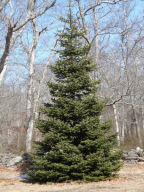 e most common members of this cosmopolitan group of trees and shrubs. Pines, spruces and firs are all conifers, but there are many more. Amongst the ancient lineage of conifers are some of the oldest, tallest, and most massive organisms on Earth.
e most common members of this cosmopolitan group of trees and shrubs. Pines, spruces and firs are all conifers, but there are many more. Amongst the ancient lineage of conifers are some of the oldest, tallest, and most massive organisms on Earth.
Polly planted dense rows of various conifers parallel to the Play Pen. The dense evergreen foliage of many conifers (some are deciduous) planted in what are known as the Conifer Rows provided a much needed windbreak to protect the choice plants growing in the Play Pen. They serve that same purpose today and also provide a striking visual element when viewed from across the West Field.
 Visitors can explore a bounty of conifers throughout the grounds that includes specimens from 23 genera from five continents. Some of the more unique specimens include the bizarre looking monkey puzzles (Araucaria araucana) from South America’s Andes Mountains, the deciduous Chinese dawn redwood (Metasequoia glptostroboides) known only from fossil records until the 1940’s, and the tree that is the source of wood used in the production of pencils, the incense cedar (Calocedrus decurrens). Read more about conifers at PHA.
Visitors can explore a bounty of conifers throughout the grounds that includes specimens from 23 genera from five continents. Some of the more unique specimens include the bizarre looking monkey puzzles (Araucaria araucana) from South America’s Andes Mountains, the deciduous Chinese dawn redwood (Metasequoia glptostroboides) known only from fossil records until the 1940’s, and the tree that is the source of wood used in the production of pencils, the incense cedar (Calocedrus decurrens). Read more about conifers at PHA.
Hollies
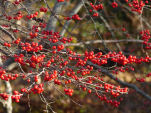 Various species of the diverse group of evergreen and deciduous trees and shrubs known as hollies (Ilex) play a significant role in the folklore, legend and ceremony of many cultures and religions. Today, much of their value is derived from their many garden attributes and adaptability to a variety of garden settings and uses. Hollies are dioecious meaning that they bear male flowers and female flowers on separate plants. Only the plants producing female flowers (if pollinated by a nearby male plant) will bear the fruit which is often brightly colored and a great asset in the Winter garden.
Various species of the diverse group of evergreen and deciduous trees and shrubs known as hollies (Ilex) play a significant role in the folklore, legend and ceremony of many cultures and religions. Today, much of their value is derived from their many garden attributes and adaptability to a variety of garden settings and uses. Hollies are dioecious meaning that they bear male flowers and female flowers on separate plants. Only the plants producing female flowers (if pollinated by a nearby male plant) will bear the fruit which is often brightly colored and a great asset in the Winter garden.
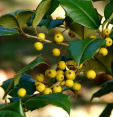 Three species of holly (Ilex) are native to Martha’s Vineyard – inkberry (Ilex glabra), American holly (Ilex opaca) and winterberry (Ilex verticillata). Nearly 100 different hollies are grown at the Arboretum including several forms of American holly and winterberry selected by Polly Hill for superior or unique characteristics such as fruit color and foliage. One of her American hollies is a yellow-fruited form named ‘Villanova’ which was discovered in her brother’s lawn as a volunteer seedling. He had been mowing it down until he took pity on it and transplanted it to the garden where Polly saw its potential as a unique and valuable garden plant.
Three species of holly (Ilex) are native to Martha’s Vineyard – inkberry (Ilex glabra), American holly (Ilex opaca) and winterberry (Ilex verticillata). Nearly 100 different hollies are grown at the Arboretum including several forms of American holly and winterberry selected by Polly Hill for superior or unique characteristics such as fruit color and foliage. One of her American hollies is a yellow-fruited form named ‘Villanova’ which was discovered in her brother’s lawn as a volunteer seedling. He had been mowing it down until he took pity on it and transplanted it to the garden where Polly saw its potential as a unique and valuable garden plant.
Rhododendrons and Azaleas
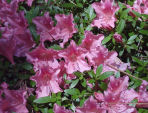 Translated directly from Greek Rhododendron means “rose tree”. Several species are, in fact, trees but the majority of the more than 1000 species are deciduous or evergreen shrubs ranging from ground hugging alpines and sub-tropical epiphytes to large, thicket forming shrubs.
Translated directly from Greek Rhododendron means “rose tree”. Several species are, in fact, trees but the majority of the more than 1000 species are deciduous or evergreen shrubs ranging from ground hugging alpines and sub-tropical epiphytes to large, thicket forming shrubs.
The well-drained, acidic soil of the Arboretum supports the successful growth of hundreds of species, cultivars and hybrids, mostly originating in temperate regions of North America and eastern Asia. Prominent in the Arboretum’s collection are Polly’s reknowned North Tisbury azaleas, selections Polly grew from seed received from her friend, and fellow keen amateur plantsman, Dr. Tsuneshige Rokujo of Japan. The semi-evergreen North Tisbury azaleas feature a low-growing habit and white and vibrantly-colored flowers in shades of pink and red. The finest specimens are found growing in Polly’s Play Pen and typically bloom from late May into mid June.
The deciduous azaleas comprise another important group at the Arboretum 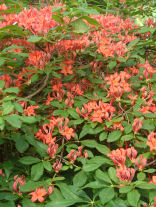 and are generally medium-sized shrubs. Collectively their season of bloom stretches from earliest April when the very hardy Korean azalea (Rhododendron mucronulatum) opens its rosy-purple blossoms on naked stems to early September when the last few vivid orange or red blossoms appear on the plum-leaf azalea (Rhododendron prunifolium), native to a narrow range along the border or Georgia and Alabama. Many are fragrant adding to their great worth as garden plants. Several fine plantings can be seen in the Arboretum Field and in Polly’s Play Pen. Read more about the Cumberland azalea.
and are generally medium-sized shrubs. Collectively their season of bloom stretches from earliest April when the very hardy Korean azalea (Rhododendron mucronulatum) opens its rosy-purple blossoms on naked stems to early September when the last few vivid orange or red blossoms appear on the plum-leaf azalea (Rhododendron prunifolium), native to a narrow range along the border or Georgia and Alabama. Many are fragrant adding to their great worth as garden plants. Several fine plantings can be seen in the Arboretum Field and in Polly’s Play Pen. Read more about the Cumberland azalea.
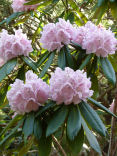 The broad-leaved evergreen rhododendrons are the third noteworthy group. As their common name suggests, these generally medium to large shrubs are clad throughout the year with leathery, glossy evergreen leaves. The leaves of some species and hybrids are attractively cloaked in a silvery or fawn-colored felty coating known as indumentum. They are amongst the most flamboyant plants at the Arboretum when they display their vivid blossoms in trusses the size of baseballs or softballs. The mature plantings in the southwest part of the West Field are particularly striking, even from across the West Field.
The broad-leaved evergreen rhododendrons are the third noteworthy group. As their common name suggests, these generally medium to large shrubs are clad throughout the year with leathery, glossy evergreen leaves. The leaves of some species and hybrids are attractively cloaked in a silvery or fawn-colored felty coating known as indumentum. They are amongst the most flamboyant plants at the Arboretum when they display their vivid blossoms in trusses the size of baseballs or softballs. The mature plantings in the southwest part of the West Field are particularly striking, even from across the West Field.